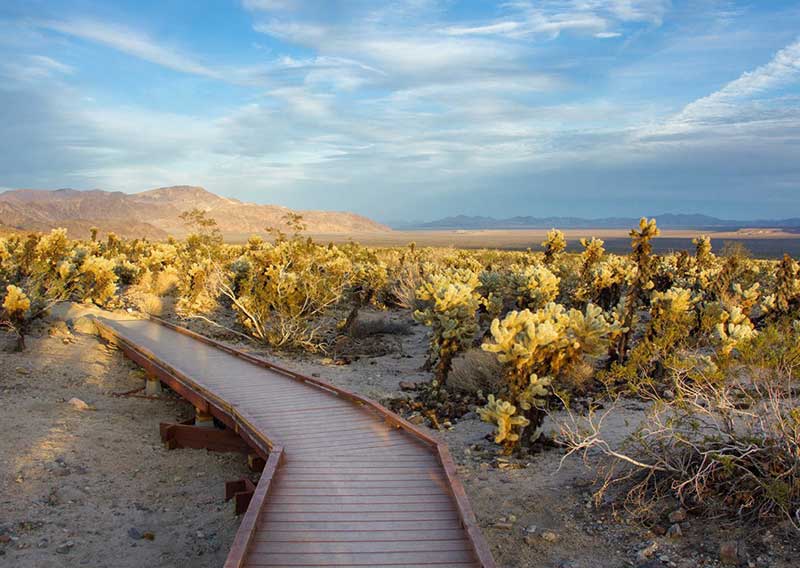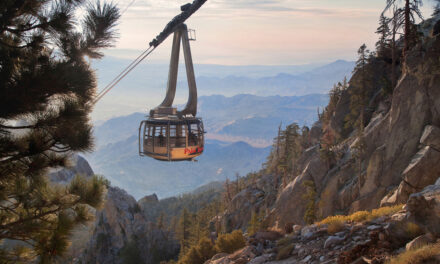Trails explore Joshua Tree National Park’s diverse plants
With several thousand feet of elevation change and the Mojave and Colorado deserts meeting in Joshua Tree National Park, an incredible variety of plants grow there. They range from the unique Joshua tree to the cholla cactus – each found in one desert rather than the other – to the ubiquitous scrub brush native to both desert floors while juniper and pinyon pine grow on mountainsides.
February and March are great times to hike Joshua Tree’s trails. Daytime highs range from the low 60’s before Valentine’s Day to the low 70’s as April approaches.
Here are some great trails at the national park to see its diverse flora.
Cholla Cactus Garden Nature Trail
The 0.25-mile trail loops through an otherworldly forest of thousands of cholla cactus in the Colorado Desert. An excellent time to visit the garden is about an hour before sunset when the cacti seem to glow in the changing light. March through April also is a great time during the day, as the teddy bear cholla are in bloom with their showy yellow to white-colored flowers.
This particular spot at the edge of the Sonoran Desert is ideal for teddy bear cholla. About 4 inches of water seasonally flows out of Wilson Canyon over a loose mixture of broken rock and soil, which nicely holds the moisture.
The teddy bear cholla, with its distinctive trunk, can grow up to 5 feet tall. A detachable sheath covers its sharp 1-inch needles. Surprisingly, most of its seeds are infertile. Instead, the teddy bear cholla reproduces when stem joints fall off.
Thanks to tiny barbs on the stem joints’ spines, they quickly latch on to anything brushing against them – including you. And as luck would have it, these barbs cause great pain when removed.
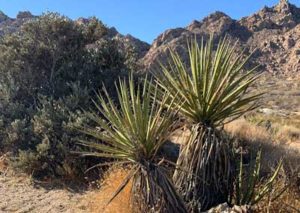
02 The Mojave yucca grows in abundance on the Indian Cove Trail.
Indian Cove Trail
Day hikers can learn how Indigenous peoples used various desert plants on this 0.6-mile loop at Indian Cove Campground’s west end. The trail is a gently rolling path with a few built-in steps.
Among the highlights is the Mojave yucca. Actually a small evergreen tree, the yucca’s bayonet-shaped leaves shoot out from a central rosette. The dead leaves droop and brown, forming a skirt around the yucca’s base. It can reach up to 16 feet high and five feet around.
Indigenous peoples used the Mojave yucca’s fibers to make rope, thread, cloth and even sandals. Its black seeds often were ground into flour while both the flower and fruit were eaten both raw and cooked. The roots were a key ingredient in soap.
Among the best times to hike the trail is a day or two after the rainfall, so be sure to follow the local weather. Many of the desert plants’ flowers will be in bloom while the tawny landscape turns green.
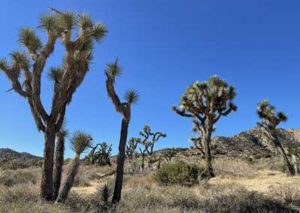
03 The Panorama Loop features a hike through a Joshua tree forest.
Panorama Loop
Hikers can explore both a dense Joshua tree forest and a pinyon-juniper woodland as climbing 1100 feet over 6.6 miles from a sandy wash to a ridge line on the Little San Bernardino Mountains. The trail leaves from the Black Rock Campground.
For desert plants, Joshua trees are fast growers. They can rise 3 inches a year for their first decade. Barring a natural calamity, the trees survive hundreds of years. The oldest ones are thought to have sprouted about 1000 CE.
Joshua trees can be found all across the Mojave Desert in California, Arizona, Nevada and Utah; indeed, some biologists suggest that the Mojave can be defined as the range of Joshua trees. The Joshua trees primarily grow between 1,300 and 5,900 feet elevation, though, so they won’t be found on the desert’s mountain tops or its low areas, such as those in Death Valley.
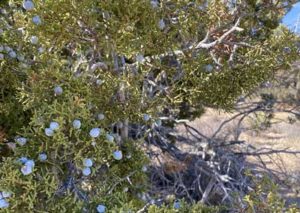
04 Juniper sports fragrant needles and blue berries on the Panorama Trail.
If hiking the trail between February and late April, you might spot the Joshua tree in bloom. Its creamy white flowers are about 1-3 inches long. Joshua trees don’t bloom every year, though; first a winter freeze and then just the right amount of rain must fall.
Pinyon-juniper woodlands typically grow on steep, rocky slopes that are dry and face east. The coniferous pinyon and juniper in the Mojave are tall and bushy. The juniper’s needles are quite fragrant, and its blues berries stand out on the beige landscape.
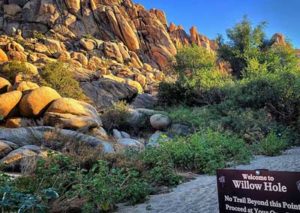
05 The verdant Willow Hole Oasis features willow and cottonwood trees, a surreal sight in the desert.
Willow Hole Trail
The flat 7.2-miles out and back trail heads to an oasis of willow trees. Along the way, you’ll travel through a Joshua tree forest, the Wonderland of Rocks boulders, and sandy washes. Start at the south terminal of the Boy Scout Trail-head off of Park Boulevard.
While for most the Wonderland’s fantastical rock formations are the trail’s highlights, the tall willow trees in the oasis are equally surreal in this stark desert. Cottonwoods also can be spotted here.
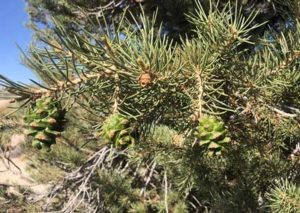
06 Pinyon pine’s californiarum subspecies grows on the Pine City Trail.
Pine City Trail
A seasonal wash enclosed by large boulders crafted a cooler, moister microclimate than the surrounding desert, and it’s perfect for pinyon pine. The trail-head of the 4.4-miles round trip hike is at the end of Desert Queen Mine Road.
A small tree, mature pinyon pines range from 30 to 66 feet high with a trunk nearly a yard in diameter. Its needles are stout and a gray-green.
Joshua Tree boasts one of the few sites of the californiarum subspecies of pinyon pine. Most pinyon pines to the north are of the monophylla subspecies, whose needles are longer and blue-green.
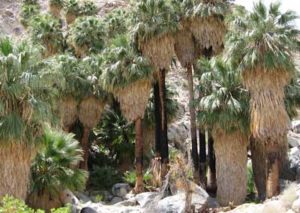
07 The Forty-nine Palms Oasis Trail cuts through largely barren and rocky terrain before arriving at this green spot.
Forty-nine Palms Oasis Trail
What would a desert be without an oasis? Day hikers can head to a secluded oasis of California fan palm on this 2.8-mile round trip trail.
After walking a single track through a rocky landscape dominated by barrel cacti and brittlebush, like a desert mirage the oasis seemingly pops out on the horizon.
The palm trees rise between boulders that shade a trickling spring and its pool, which sometimes goes dry. It’s the only palm native to the Western United States. When the fan palm’s fronds die, they droop around the trunk, forming a skirt protecting it from the desert sun. Many small birds – among them the brilliantly colored orange-yellow hooded oriole – make their homes in the skirt and feed on the tree’s ripe berry-like fruit.
A hardy plant, the fan palm can live up to 250 years. In the decades ahead, you’ll probably see more of them across Southern California, as their range is expanding due to global warming.
Image Sources
- 02-The-Mojave-yicca-400×284-1: Rob Bignell
- 03-The-panorama-Loop-400×284-1: Rob Bignell
- 04-Juniper-Sports-fragrant-needles-400×284-1: Rob Bignell
- 05-The-Verdant-Willow-Hole-Oasis-400×284-1: Rob Bignell
- 06-Pinyon-Pines-400×284-1: Rob Bignell
- 07-The-Fortynine-Palms-Oasis0Trail-400×284-1: Rob Bignell
- 01-Thousands-ofteddybear-cholla-pacj-800×568-1: Rob Bignell

